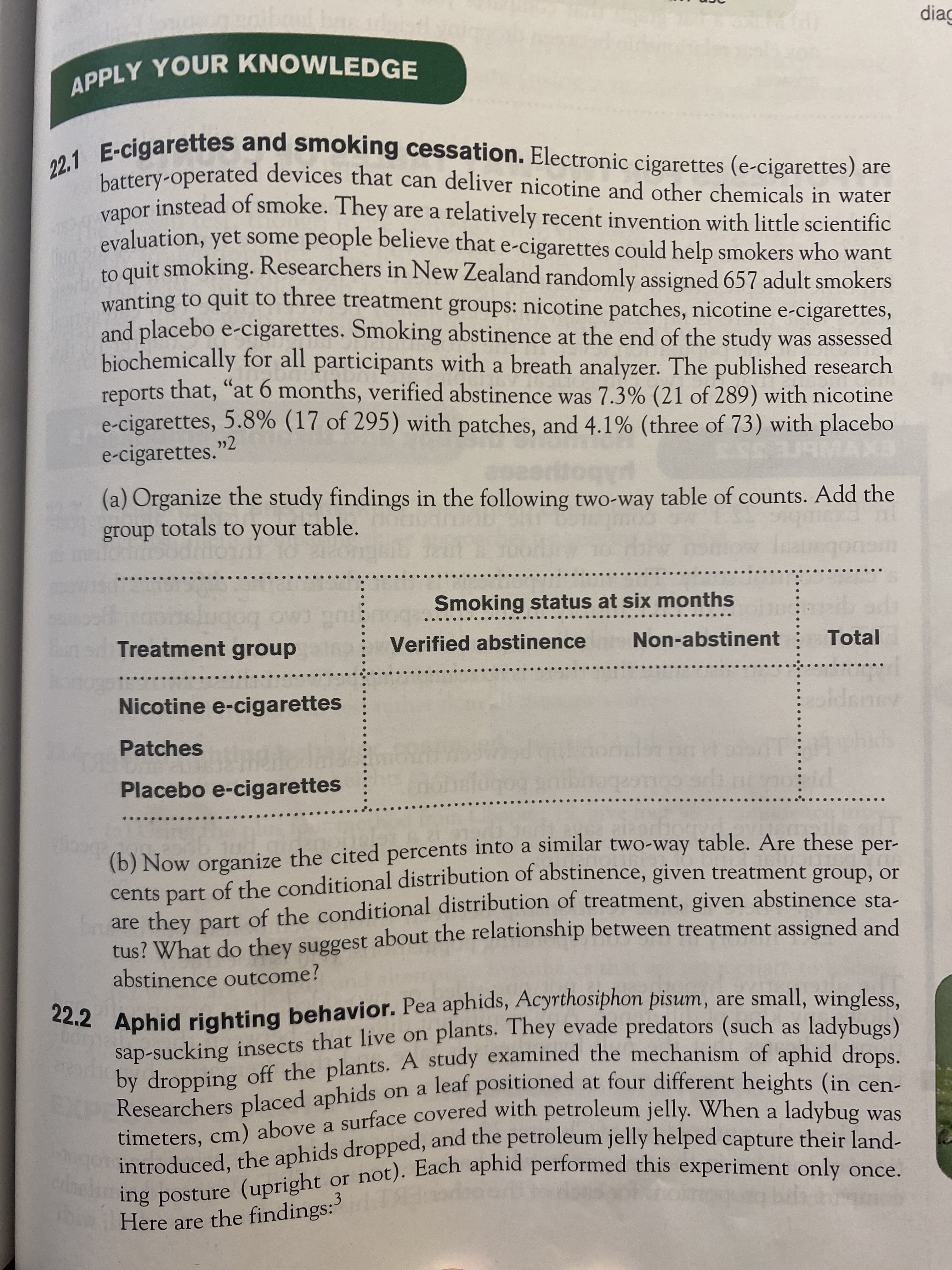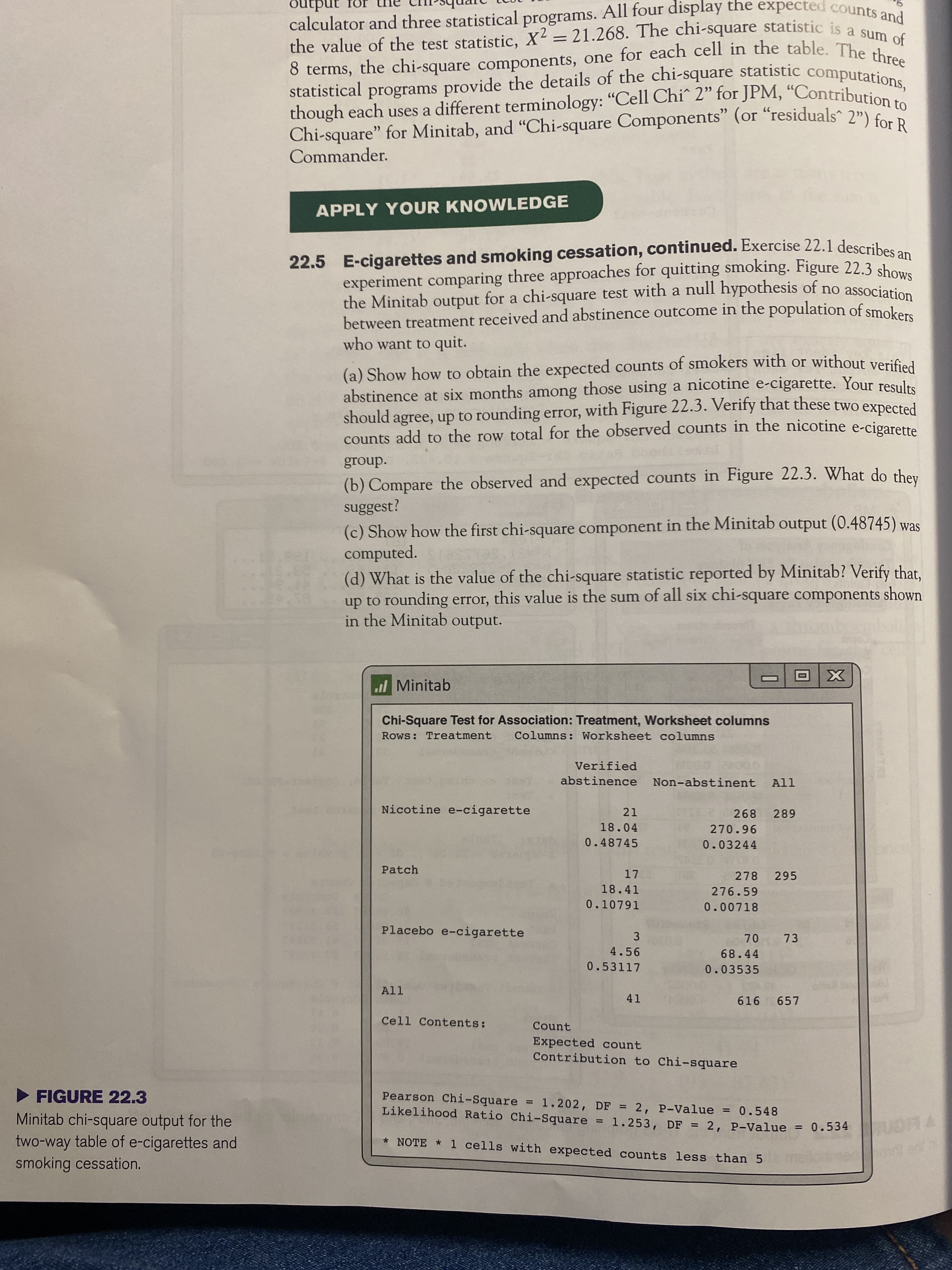22.5 E-cigarettes and smoking cessation, continued. Exercise 22.1 describes an experiment comparing three approaches for quitting smoking. Figure 22.3 shows between treatment received and abstinence outcome in the population of smokers experiment comparing three approaches for quitting smoking. Figure 22.3 sho the Minitab output for a chi-square test with a null hypothesis of no association between treatment received and abstinence outcome in the population of smol who want to quit. (a) Show how to obtain the expected counts of smokers with or without verified abstinence at six months among those using a nicotine e-cigarette. Your resulte should agree, up to rounding error, with Figure 22.3. Verify that these two expected counts add to the row total for the observed counts in the nicotine e-cigarette group. (b) Compare the observed and expected counts in Figure 22.3. What do they suggest? (c) Show how the first chi-square component in the Minitab output (0.48745) was computed. 11
22.5 E-cigarettes and smoking cessation, continued. Exercise 22.1 describes an experiment comparing three approaches for quitting smoking. Figure 22.3 shows between treatment received and abstinence outcome in the population of smokers experiment comparing three approaches for quitting smoking. Figure 22.3 sho the Minitab output for a chi-square test with a null hypothesis of no association between treatment received and abstinence outcome in the population of smol who want to quit. (a) Show how to obtain the expected counts of smokers with or without verified abstinence at six months among those using a nicotine e-cigarette. Your resulte should agree, up to rounding error, with Figure 22.3. Verify that these two expected counts add to the row total for the observed counts in the nicotine e-cigarette group. (b) Compare the observed and expected counts in Figure 22.3. What do they suggest? (c) Show how the first chi-square component in the Minitab output (0.48745) was computed. 11
Glencoe Algebra 1, Student Edition, 9780079039897, 0079039898, 2018
18th Edition
ISBN:9780079039897
Author:Carter
Publisher:Carter
Chapter10: Statistics
Section10.3: Measures Of Spread
Problem 1GP
Related questions
Question
22.5 please! Thanks

Transcribed Image Text:introduced, the aphids and jelly helped land-
ing or not). Each aphid this only once.
timeters, cm) a with jelly. a was
diag
F-cigarettes and smoking cessation. Electronic cigarettes (e-cigarettes) are
hortery-operated devices that can deliver nicotine and other chemicals in water
instead of smoke. They are a relatively recent invention with little scientific
vapor
evaluation, yet some people believe that e-cigarettes could help smokers who want
re quit smoking. Researchers in New Zealand randomly assigned 657 adult smokers
wanting to quit to three treatment groups: nicotine patches, nicotine e-cigarettes,
and placebo e-cigarettes. Smoking abstinence at the end of the study was assessed
biochemically for all participants with a breath analyzer. The published research
reports that, "at 6 months, verified abstinence was 7.3% (21 of 289) with nicotine
e-cigarettes, 5.8% (17 of 295) with patches, and 4.1% (three of 73) with placebo
e-cigarettes."2
EXT
(a) Organize the study findings in the following two-way table of counts. Add the
group totals to your table.
..
..
.
Smoking status at six months
Treatment group
Verified abstinence
Non-abstinent
Total
Nicotine e-cigarettes
Patches
Placebo e-cigarettes
...
(b) Now organize the cited percents into a similar two-way table. Are these per-
cents part of the conditional distribution of abstinence, given treatment group, or
becuk
bm are they part of the conditional distribution of treatment, given abstinence sta-
tus? What do they suggest about the relationship between treatment assigned and
abstinence outcome?
Aphid righting behavior. Pea aphids, Acyrthosiphon pisum, are small, wingless
sap-sucking insects that live on plants. They evade predators (such as ladvbuge
by dropping off the plants. A study examined the mechanism of anhid dre
Researchers placed aphids on a leat positioned at four different heights (in cen
timeters, cm) above a surface covered with petroleum jelly. When a ladyhue
introduced, the aphids dropped, and the petroleum jelly helped capture their land
Here are the findings: od

Transcribed Image Text:calculator and three statistical programs. All four display the expected counts
the value of the test statistic, X2 = 21.268. The chi-square statistic is a nd
8 terms, the chi-square components, one for each cell in the table. The thor
statistical
though each uses a different terminology: "Cell Chi^ 2" for JPM, "Contriburions,
Chi-square" for Minitab, and "Chi-square Components" (or "residuals^ 2") f o
Commander.
output for
APPLY YOUR KNOWLEDGE
22.5 E-cigarettes and smoking cessation, continued. Exercise 22.1 describes o
experiment comparing three approaches for quitting smoking. Figure 22.3 sh
the Minitab output for a chi-square test with a null hypothesis of no associatio
between treatment received and abstinence outcome in the population of smoker
who want to quit.
(a) Show how to obtain the expected counts of smokers with or withour verife i
abstinence at six months among those using a nicotine e-cigarette. Your resulte
should agree, up to rounding error, with Figure 22.3. Verify that these two expected
counts add to the row total for the observed counts in the nicotine e-cigarette
group.
(b) Compare the observed and expected counts in Figure 22.3. What do ther
suggest?
(c) Show how the first chi-square component in the Minitab output (0.48745) was
computed.
(d) What is the value of the chi-square statistic reported by Minitab? Verify that,
up to rounding error, this value is the sum of all six chi-square components shown
in the Minitab output.
lMinitab
Chi-Square Test for Association: Treatment, Worksheet columns
Rows: Treatment
Columns: Worksheet columns
Verified
abstinence
Non-abstinent All
Nicotine e-cigarette
21
268
687
18.04
270.96
0.48745
0.03244
Patch
LT
18.41
278 295
276.59
0.10791
0.00718
Placebo e-cigarette
OL
68.44
3
73
4.56
0.53117
0.03535
41
616 657
Cell Contents:
Count
Expected count
Contribution to Chi-square
> FIGURE 22.3
Minitab chi-square output for the
two-way table of e-cigarettes and
smoking cessation.
Pearson Chi-Square = 1.202, DF = 2, P-Value = 0.548
Likelihood Ratio Chi-Square = 1.253, DF = 2, P-Value = 0.534
%3D
%3D
* NOTE * 1 cells with expected counts less than 5
Expert Solution
This question has been solved!
Explore an expertly crafted, step-by-step solution for a thorough understanding of key concepts.
This is a popular solution!
Trending now
This is a popular solution!
Step by step
Solved in 4 steps

Recommended textbooks for you

Glencoe Algebra 1, Student Edition, 9780079039897…
Algebra
ISBN:
9780079039897
Author:
Carter
Publisher:
McGraw Hill

Holt Mcdougal Larson Pre-algebra: Student Edition…
Algebra
ISBN:
9780547587776
Author:
HOLT MCDOUGAL
Publisher:
HOLT MCDOUGAL

Glencoe Algebra 1, Student Edition, 9780079039897…
Algebra
ISBN:
9780079039897
Author:
Carter
Publisher:
McGraw Hill

Holt Mcdougal Larson Pre-algebra: Student Edition…
Algebra
ISBN:
9780547587776
Author:
HOLT MCDOUGAL
Publisher:
HOLT MCDOUGAL